 GA800 Drive
GA800 Drive
The GA800 drive provides the ultimate combination of power, ease of use, flexibility, and performance. In addition to its exceptional torque production and precise control, you’ll enjoy effortless setup with GA800’s high-resolution display and connection to your favorite mobile device. Whether you need simple control, advanced network communications, or functional safety, look no further than GA800 for all your variable speed needs.
 A1000 Drive
A1000 Drive
The A1000 is a full featured drive, providing outstanding quality, performance, flexibility, and environmental friendliness through 1000HP. Enjoy network communications, feedback, and expandable I/O to control anything from simple fans and pumps to complex machines.
- A1000 600V AC Drive
- Specifications and Features for A1000 600V Drive
- Models & Ratings for A1000 600V Drive
- Network Communications Options for A1000 600V Drive
- Input, Output, and Keypad Options for A1000 600V Drive
 U1000 Industrial MATRIX Drive
U1000 Industrial MATRIX Drive
The U1000 is a compact all-in-one solution for ultra-low harmonics and/or full regeneration, and is the ultimate choice for power quality and energy savings. Additionally, the U1000 delivers high flexibility and motor control performance to meet a wide variety of application requirements.
 V1000 Drive
V1000 Drive
The V1000 is a world-class compact current vector drive that defines a new world standard. Demands for efficient production and better maintainability are on the rise, spurred by global competition. Yaskawa pays off the promise of being in control with products that make businesses move.
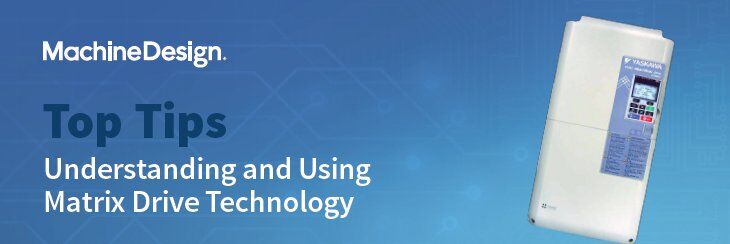
Whether used in simple applications like pumps and fans or more complicated applications like winders and dynamometers, Variable Speed Drives (VSDs) need to provide new and improved process control, while also boosting power factor and overall system efficiency. This requires the clean and efficient use of line power—something Matrix Drive Technology can provide.
- Understand the basic method used by conventional drives for power conversion.
A conventional drive converts ac to dc using diodes, which only conduct when the voltage at the anode (ac side) is greater than the cathode (dc side). Because dc generated from a diode rectifier is not uniform (only the peaks of the ac input voltages are higher than the dc supply) a dc ripple occurs from the conversion process. Therefore, a conventional drive is forced to incorporate a large number of electrolytic capacitors to smooth the dc ripple.
This smoothed dc voltage is used to generate an output voltage waveform to control a motor at the requested frequency. The output is a pulsed dc voltage waveform known as pulse width modulation (PWM). These pulses are filtered by the impedance of the motor, which allows the motor to react to the PWM voltage as if it were sinusoidal.
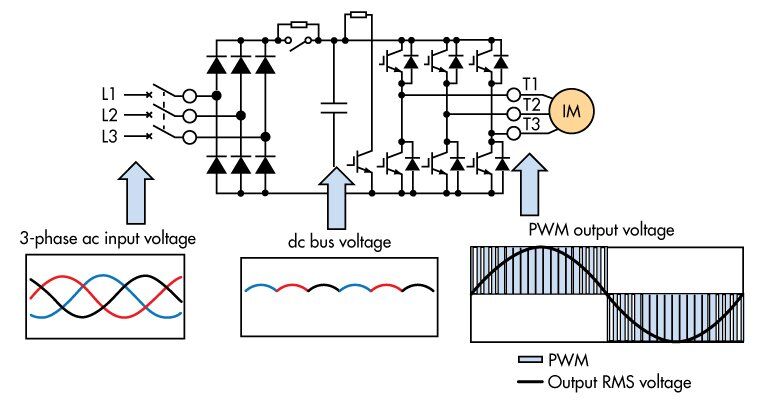
- Understand the matrix difference.
Unlike conventional VSDs that convert ac to dc through a rectifier and then back to an ac output suitable for control, Matrix Drives use a system of nine bi-directional switches (IGBTs) to convert a three-phase ac input voltage directly into a three-phase ac output voltage. A compact input PWM filter isolates the switches from the supply and mitigates the regenerative PWM waveform to provide a clean sine wave back to the line.
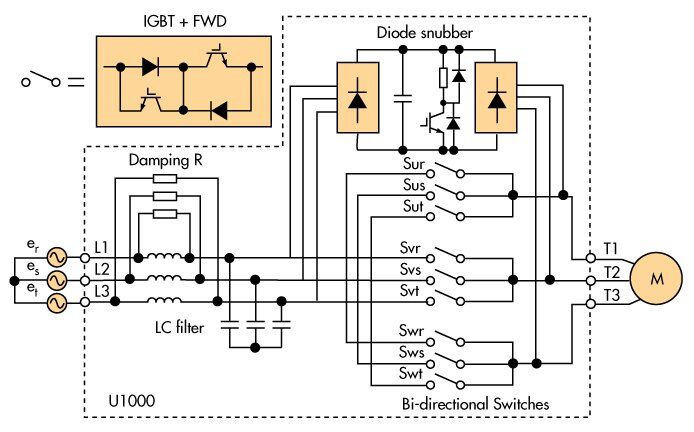
- Understand the makeup of a matrix drive.
Breaking down the Matrix drive can help to better understand how it works. The Matrix drive can be described as using three sets of matrices, each of which connects between the input power and one output phase. The matrix consists of three of the nine bi-directional IGBTs. A simple way to think of this is that the supply voltage is outputted to the motor by closing one of the three IGBTs. Therefore, no more than one IGBT can be turned ON at the same time. Since each of the matrices represents a connection to only one output phase, the drive incorporates three sets of matrices for each output phase to the motor.
All three matrices are also connected to the same power source; therefore, each input phase can be connected at a common point simplifying the overall circuit. Plus, each motor phase has independent access to the line. This is how the matrix drive achieves its three-wire input and three-wire output power wiring capability. - Understand the advantages of matrix drives.
Unlike other harmonic current solutions, the matrix drive does not force current into the drive to reduce harmonics. The drive draws current with low harmonic content naturally. This allows the matrix drive to operate at rated power with less than 5% iTHD at the input of the drive with a near unity power factor of 0.98 or better at rated load. The matrix drive is an all-around green solution. This means that the matrix drive’s input current draw contains low harmonics throughout the load profile. The low harmonic capabilities of the matrix drive easily facilitates IEEE 519 compliance.
Other advantages include full continuous regeneration; compact size; higher efficiency compared to equivalent performing systems; across-the-line operation through the drive; and induction motor and permanent magnet motor control. - Understand the breadth of applications that could benefit from matrix drives.
Matrix drives are suitable for applications where reducing input current harmonics, boosting power factor, and/or simplifying installation are critical requirements prior to purchase. Two common applications that benefit from these specific Matrix drive attributes are pumps and fans. Matrix drives are also useful for applications that experience regeneration, such as test dynamometers. Regenerative energy is seamlessly and automatically put back onto the line by the matrix drive to be distributed to other loads on the system and reduce utility billing. Depending on the regenerative application, users may also desire reduced harmonics, reduced size, and a boost in efficiency.



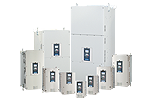 GA800 Drive
GA800 Drive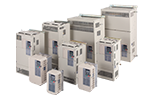
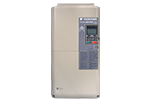 U1000 Industrial MATRIX Drive
U1000 Industrial MATRIX Drive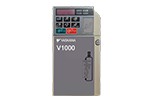 V1000 Drive
V1000 Drive